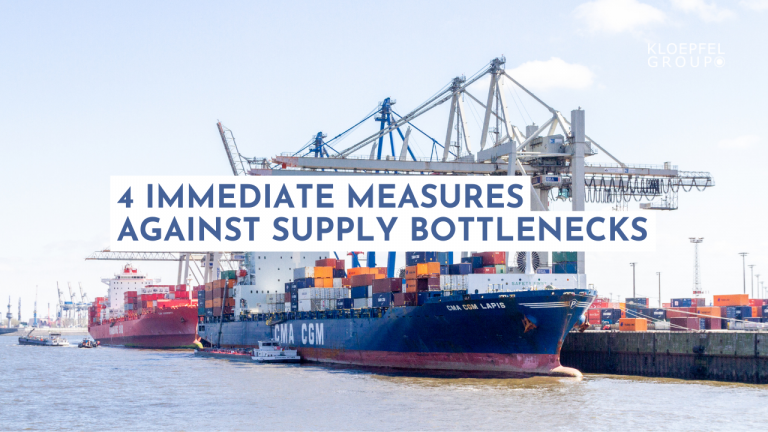Disrupted supply chains: Medium-sized companies
- Risk analysis
- Optimize inventory management
- Make raw material costs transparent
- Find alternative sources of supply
With this press release, the purchasing and logistics consultancy Kloepfel Consulting provides German companies with tips on what to do about the currently prevailing supply bottlenecks and lunar prices due to globally disrupted supply chains.
1. Risk analysis
The key issues for your own company should be quickly identified and reprioritized with a risk analysis. The risk analysis should be conducted by commodity group, supplier and country to derive structured actions to address the risk. The war in Ukraine and the impact of sanctions also suggest a renewed task force for many companies.
2. Optimize inventory management
One obvious measure is to increase the order volume and stock up the company’s own warehouse. Finding additional storage space or negotiating with the warehouse already in use to expand storage capacity are steps that should be considered for this purpose. In doing so, it must be well considered how much money one wants to tie up in the warehouse in favor of supply security.
3. Make raw material costs transparent
Companies are currently running out of costs. It is not unusual for companies not to be directly aware of the impact of raw material costs on their product costs. However, transparency in this regard is an absolute must. Companies should break down their cost structure into the most important cost blocks and demand the same from suppliers. Open calculations are the basis for real partnerships, not just lip service. Only with a transparent cost structure can the right and important next steps be defined. These can range from renegotiations, benchmarking, tenders, technical value analyses to the search for substitutes and workshops with suppliers.
4. Find alternative sources of supply

Tap alternative suppliers, explore hidden overcapacities in the market, request networks of associations, the buyer community and purchasing consultants across industries. Although automotive and mechanical engineering, for example, have different characteristics, they can sometimes use the same suppliers to their advantage. Some manufacturers supply not only automotive volume buyers, but also special vehicle construction or general mechanical engineering. If companies in weakening sectors are doing badly, it may well be that their suppliers have unrecognized overcapacities from which SMEs in flourishing sectors can benefit. That’s why it’s also worth asking around the world and networking to find out who knows which suppliers and which traders for which material groups.
Our experience shows that many suppliers and technical distributors around the globe are interesting in bridging supply bottlenecks. The industries are affected differently in the different countries of the world. Therefore, certain raw materials or components are less in demand in one country than in others and are therefore cheaper or more available. Therefore it is worthwhile to look at other European countries or Asia. In some cases, there are international inventories that one would not expect, but which can be tracked down through digital global sourcing.
Another lever can be “friendly” companies that may still have material in stock.
Contact:
Kloepfel Group
Christopher Willson
Tel.: 0211 941 984 33
Pempelforter Str. 50
40211 Duesseldorf
Mail: rendite@kloepfel-consulting.com
